

Compact Muon Solenoid
LHC, CERN
| CMS-PAS-SMP-24-013 | ||
| Combination of vector boson scattering measurements with fully- and semi-leptonic final states in proton-proton collisionsat $ \sqrt{s} = $ 13 TeV | ||
| CMS Collaboration | ||
| 2 April 2025 | ||
| Abstract: A statistical combination of vector boson scattering measurements is presented, incorporating fully leptonic and semileptonic decay channels from proton-proton collisions at $ \sqrt{s} = $ 13 TeV. The analysis is based on a dataset corresponding to an integrated luminosity of 138 fb$ ^{-1} $, collected with the CMS detector between 2016 and 2018. All selected events feature at least two jets with a high invariant mass, large pseudorapidity separation, and at least one heavy vector boson decaying leptonically. A combined measurement of the signal strengths is performed for the production of two same-sign W bosons, two opposite-sign W bosons, two Z bosons, and a WZ final state, comparing the results to Standard Model predictions. Additionally, the measurement is reported separately for different W boson charge states. | ||
| Links: CDS record (PDF) ; Physics Briefing ; CADI line (restricted) ; | ||
| Figures | |
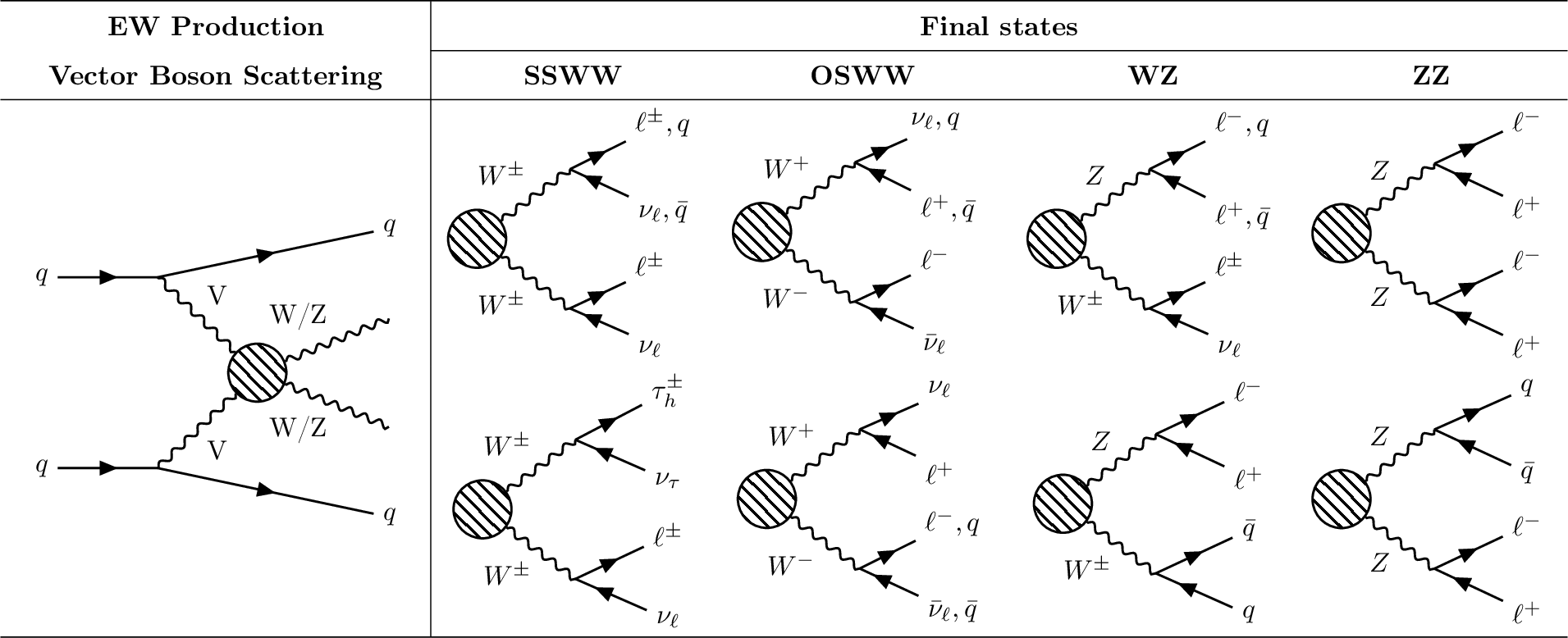
png pdf |
Figure 1:
The left side shows a representative Feynman diagram for the EW-induced production of VBS involving massive vector bosons. The dashed circle encapsulates different contributions leading to the same final state, including triple and quartic gauge couplings as well as Higgs-boson exchange. On the right, the considered decay channels are categorized into same-sign WW (SSWW), opposite-sign WW (OSWW), WZ, and ZZ pairs, covering both leptonic and semileptonic modes. In all cases, at least one vector boson is required to decay leptonically. |
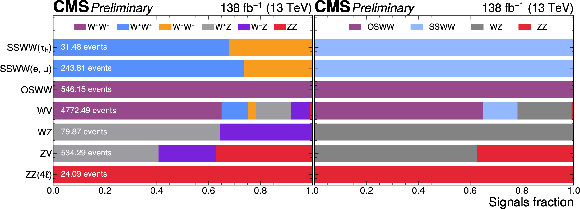
png pdf |
Figure 2:
The signal fractions for each analysis contributing to the combination are presented. Rows correspond to the names of the analyses, while the x-axis indicates the signal fraction. Different colors, as shown in the legend, represent the distinct signal parameters targeted for measurement. The left half of the figure displays the signal fractions for the six components, separated by the electric charge of the W bosons. The right half of the figure provides the equivalent information for the four components. All signal yields are computed before the combined fit to the signal strengths and including all analyses regions. |
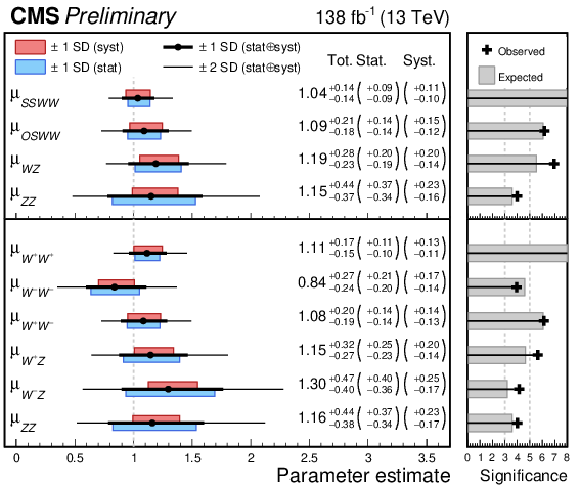
png pdf |
Figure 3:
Measurement of the vector boson scattering (VBS) signal strength modifiers ($ \mu_{i} $) and comparison with Standard Model (SM) predictions. The top (bottom) panel presents results considering four (six) independent signal strengths. In each panel, the left side shows the measured signal strengths, with thick (thin) black lines representing the 1 (2) standard deviation confidence intervals. The red and blue bands within the 1 standard deviation interval illustrate the systematic and statistical uncertainties, respectively. The right side displays the observed (black crosses) and expected (filled grey bars) statistical significance of the electroweak VBS signal relative to the SM background. |
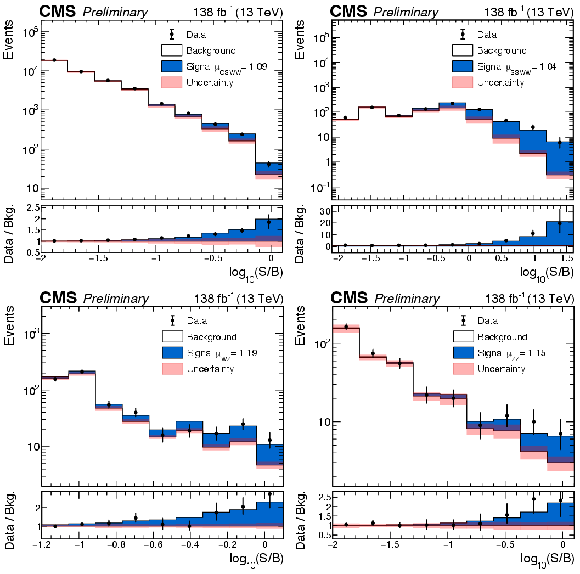
png pdf |
Figure 4:
Observed $ \log[S(\mu_i=1)/B] $ distributions for the VBS SM combination and four parameters model. From left to right, the filled white histograms represent the overall background contributions while the blue histograms represent the signal yields for $ \mu_{OSWW} $, $ \mu_{SSWW} $, $ \mu_{WZ} $ and $ \mu_{ZZ} $. The post-fit 68% uncertainty band on the overall background template is shown in pink. The distribution is binned as a function of the prefit value of $ \log[S(\mu_i=1)/B] $ and is filled with the post-fit yields of signal and backgrounds. The latter are assigned to the dominant signal contribution in a specific bin of the input templates. |
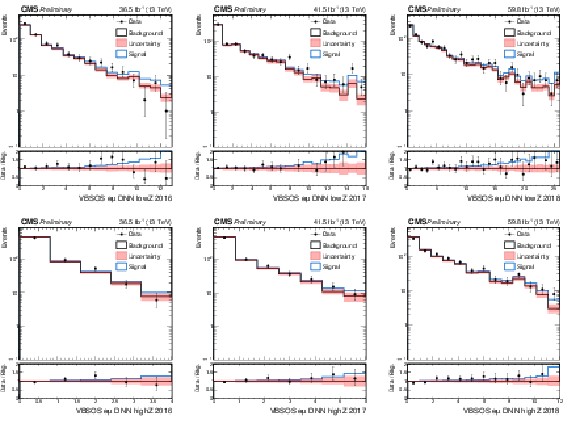
png pdf |
Figure 5:
Distributions of the DNN scores for the OSWW analysis in the signal $ e\mu $ region after the combined fit. The signal region is divided into two sub-regions based on the Zeppenfeld variable ($ Z_{\ell\ell} $), with values either greater or smaller than one. The top and bottom rows show the distributions for $ Z_{\ell\ell} < $ 1 and $ Z_{\ell\ell} > $ 1, respectively. From left to right, the plots correspond to the 2016, 2017, and 2018 data-taking periods. |
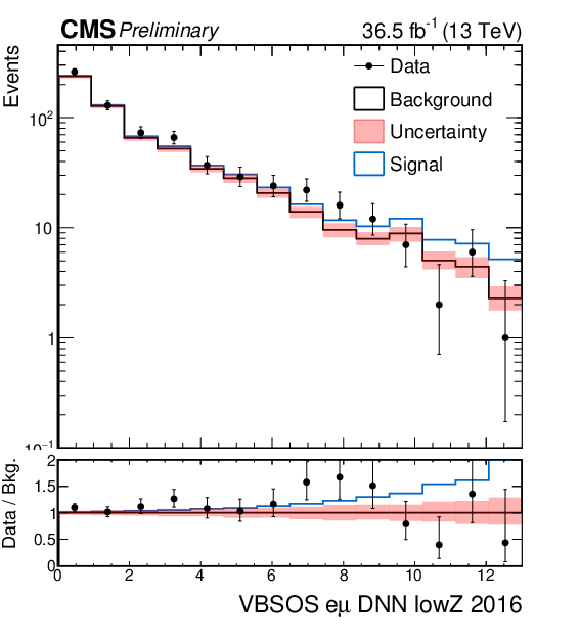
png pdf |
Figure 5-a:
Distributions of the DNN scores for the OSWW analysis in the signal $ e\mu $ region after the combined fit. The signal region is divided into two sub-regions based on the Zeppenfeld variable ($ Z_{\ell\ell} $), with values either greater or smaller than one. The top and bottom rows show the distributions for $ Z_{\ell\ell} < $ 1 and $ Z_{\ell\ell} > $ 1, respectively. From left to right, the plots correspond to the 2016, 2017, and 2018 data-taking periods. |
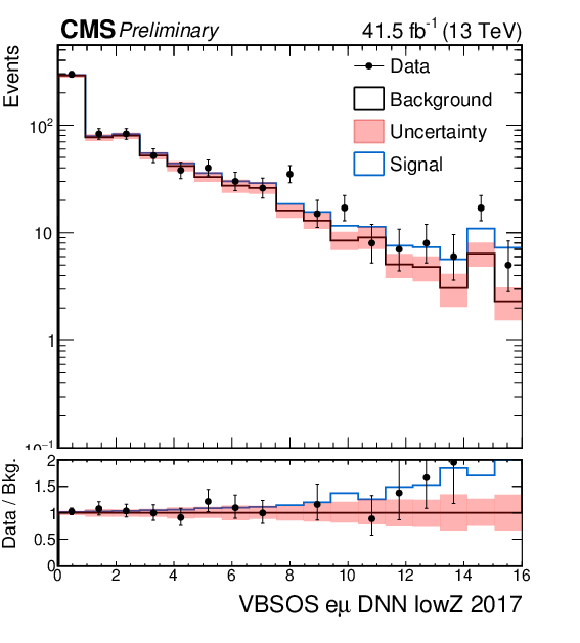
png pdf |
Figure 5-b:
Distributions of the DNN scores for the OSWW analysis in the signal $ e\mu $ region after the combined fit. The signal region is divided into two sub-regions based on the Zeppenfeld variable ($ Z_{\ell\ell} $), with values either greater or smaller than one. The top and bottom rows show the distributions for $ Z_{\ell\ell} < $ 1 and $ Z_{\ell\ell} > $ 1, respectively. From left to right, the plots correspond to the 2016, 2017, and 2018 data-taking periods. |
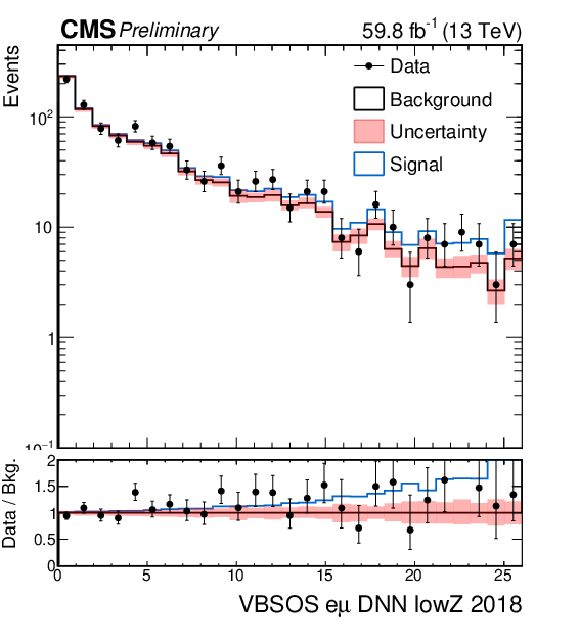
png pdf |
Figure 5-c:
Distributions of the DNN scores for the OSWW analysis in the signal $ e\mu $ region after the combined fit. The signal region is divided into two sub-regions based on the Zeppenfeld variable ($ Z_{\ell\ell} $), with values either greater or smaller than one. The top and bottom rows show the distributions for $ Z_{\ell\ell} < $ 1 and $ Z_{\ell\ell} > $ 1, respectively. From left to right, the plots correspond to the 2016, 2017, and 2018 data-taking periods. |
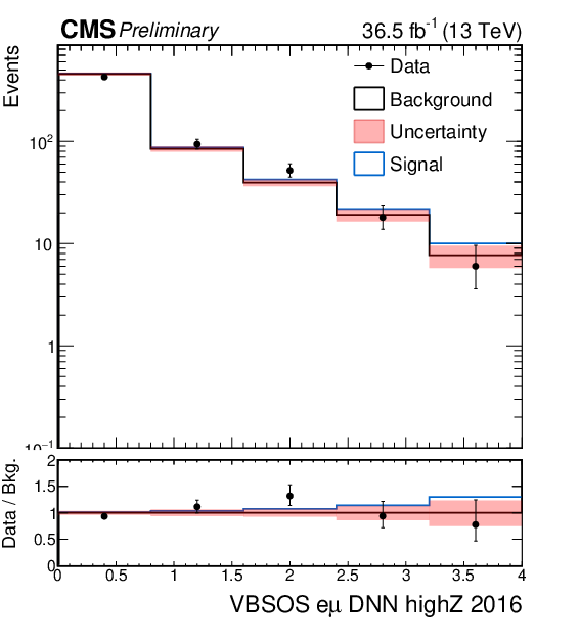
png pdf |
Figure 5-d:
Distributions of the DNN scores for the OSWW analysis in the signal $ e\mu $ region after the combined fit. The signal region is divided into two sub-regions based on the Zeppenfeld variable ($ Z_{\ell\ell} $), with values either greater or smaller than one. The top and bottom rows show the distributions for $ Z_{\ell\ell} < $ 1 and $ Z_{\ell\ell} > $ 1, respectively. From left to right, the plots correspond to the 2016, 2017, and 2018 data-taking periods. |
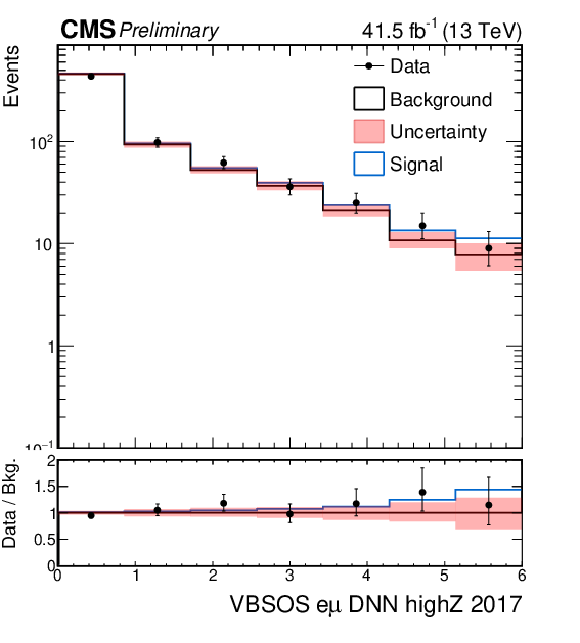
png pdf |
Figure 5-e:
Distributions of the DNN scores for the OSWW analysis in the signal $ e\mu $ region after the combined fit. The signal region is divided into two sub-regions based on the Zeppenfeld variable ($ Z_{\ell\ell} $), with values either greater or smaller than one. The top and bottom rows show the distributions for $ Z_{\ell\ell} < $ 1 and $ Z_{\ell\ell} > $ 1, respectively. From left to right, the plots correspond to the 2016, 2017, and 2018 data-taking periods. |
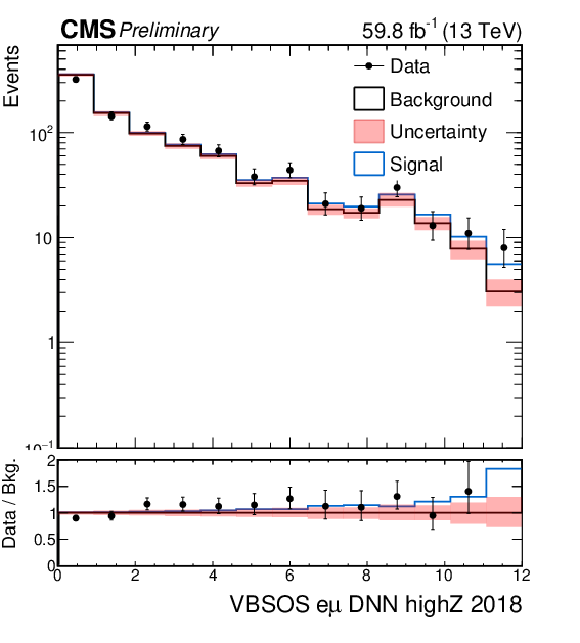
png pdf |
Figure 5-f:
Distributions of the DNN scores for the OSWW analysis in the signal $ e\mu $ region after the combined fit. The signal region is divided into two sub-regions based on the Zeppenfeld variable ($ Z_{\ell\ell} $), with values either greater or smaller than one. The top and bottom rows show the distributions for $ Z_{\ell\ell} < $ 1 and $ Z_{\ell\ell} > $ 1, respectively. From left to right, the plots correspond to the 2016, 2017, and 2018 data-taking periods. |
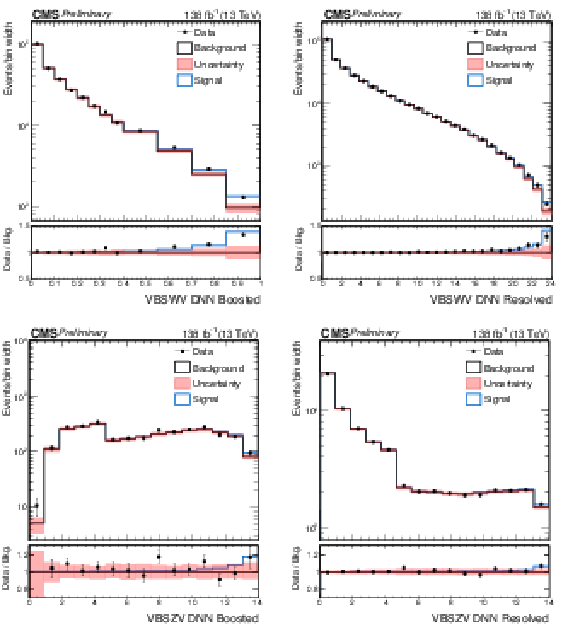
png pdf |
Figure 6:
Distributions for the signal regions of the semileptonic VBS analyses after the combined fit. The top row shows the DNN spectra of the WV analysis merged for the electron and muon cateogries in the boosted signal region (left) and in the resolved signal region (right). The bottom row shows the DNN spectra of the ZV analysis in the boosted signal region (left) and in the resolved signal region (right). |
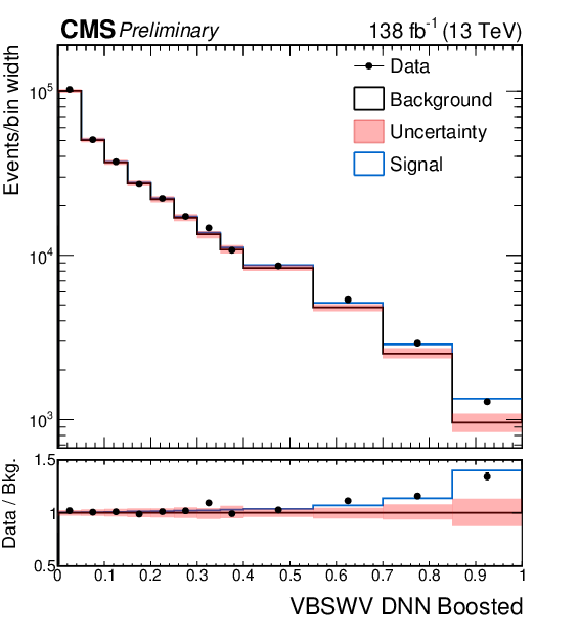
png pdf |
Figure 6-a:
Distributions for the signal regions of the semileptonic VBS analyses after the combined fit. The top row shows the DNN spectra of the WV analysis merged for the electron and muon cateogries in the boosted signal region (left) and in the resolved signal region (right). The bottom row shows the DNN spectra of the ZV analysis in the boosted signal region (left) and in the resolved signal region (right). |
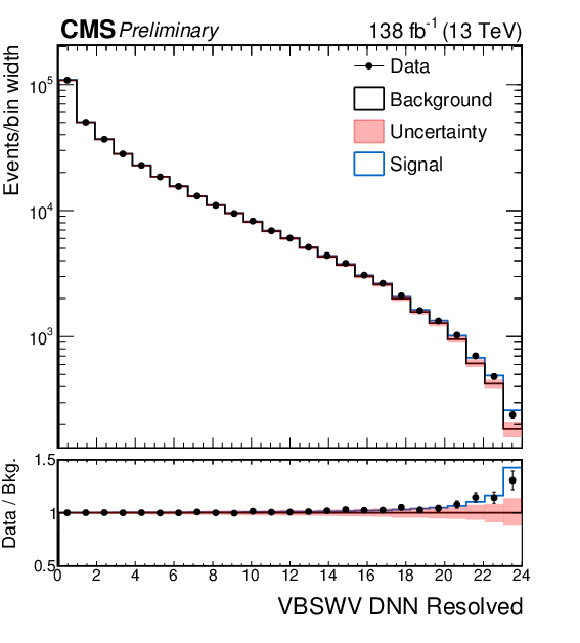
png pdf |
Figure 6-b:
Distributions for the signal regions of the semileptonic VBS analyses after the combined fit. The top row shows the DNN spectra of the WV analysis merged for the electron and muon cateogries in the boosted signal region (left) and in the resolved signal region (right). The bottom row shows the DNN spectra of the ZV analysis in the boosted signal region (left) and in the resolved signal region (right). |
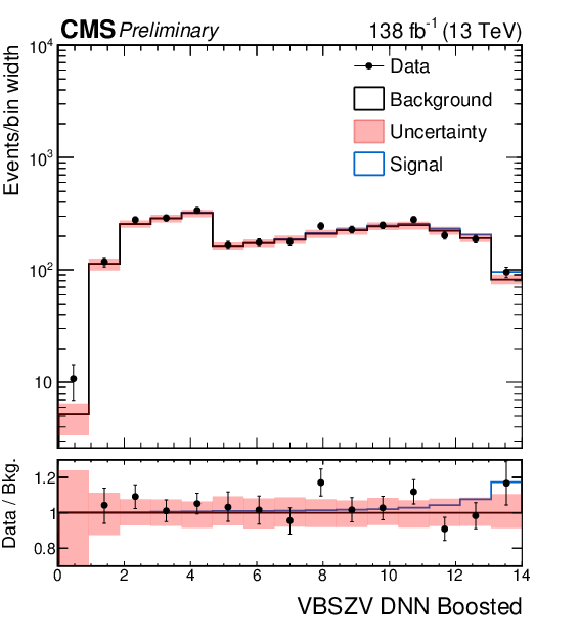
png pdf |
Figure 6-c:
Distributions for the signal regions of the semileptonic VBS analyses after the combined fit. The top row shows the DNN spectra of the WV analysis merged for the electron and muon cateogries in the boosted signal region (left) and in the resolved signal region (right). The bottom row shows the DNN spectra of the ZV analysis in the boosted signal region (left) and in the resolved signal region (right). |
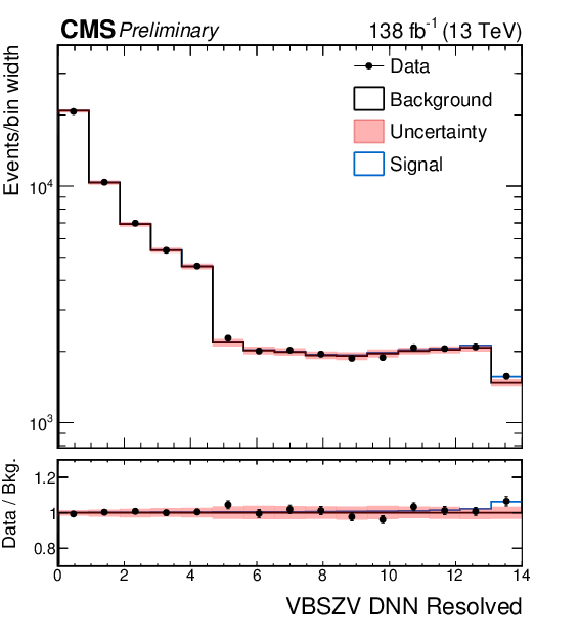
png pdf |
Figure 6-d:
Distributions for the signal regions of the semileptonic VBS analyses after the combined fit. The top row shows the DNN spectra of the WV analysis merged for the electron and muon cateogries in the boosted signal region (left) and in the resolved signal region (right). The bottom row shows the DNN spectra of the ZV analysis in the boosted signal region (left) and in the resolved signal region (right). |
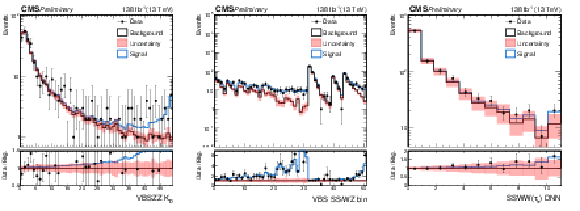
png pdf |
Figure 7:
The left figure shows the distribution of the $ K_{D} $ discriminant used to separate the VBS EW ZZ production from the QCD-induced one in the VBS-ZZ(4 $ \ell $) signal region. The central figure presents the distribution of the SSWW and WZ analyses in all signal and control regions entering in the combined fit. The right figure shows the distribution fo the DNN score used to separate the SSWW signal from the backgrounds in the SSWW($ \tau_h $) signal region. All distributions are shown after the combined fit. |
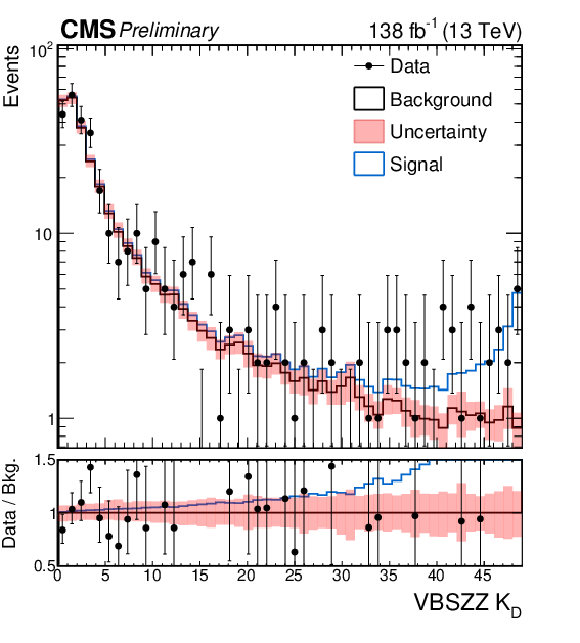
png pdf |
Figure 7-a:
The left figure shows the distribution of the $ K_{D} $ discriminant used to separate the VBS EW ZZ production from the QCD-induced one in the VBS-ZZ(4 $ \ell $) signal region. The central figure presents the distribution of the SSWW and WZ analyses in all signal and control regions entering in the combined fit. The right figure shows the distribution fo the DNN score used to separate the SSWW signal from the backgrounds in the SSWW($ \tau_h $) signal region. All distributions are shown after the combined fit. |
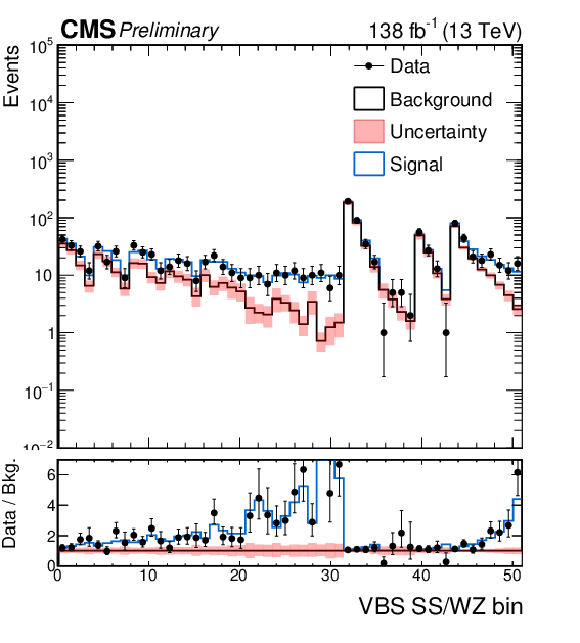
png pdf |
Figure 7-b:
The left figure shows the distribution of the $ K_{D} $ discriminant used to separate the VBS EW ZZ production from the QCD-induced one in the VBS-ZZ(4 $ \ell $) signal region. The central figure presents the distribution of the SSWW and WZ analyses in all signal and control regions entering in the combined fit. The right figure shows the distribution fo the DNN score used to separate the SSWW signal from the backgrounds in the SSWW($ \tau_h $) signal region. All distributions are shown after the combined fit. |
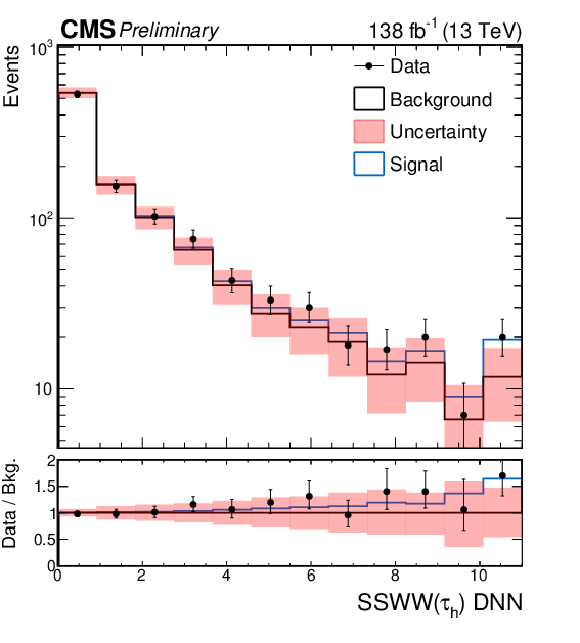
png pdf |
Figure 7-c:
The left figure shows the distribution of the $ K_{D} $ discriminant used to separate the VBS EW ZZ production from the QCD-induced one in the VBS-ZZ(4 $ \ell $) signal region. The central figure presents the distribution of the SSWW and WZ analyses in all signal and control regions entering in the combined fit. The right figure shows the distribution fo the DNN score used to separate the SSWW signal from the backgrounds in the SSWW($ \tau_h $) signal region. All distributions are shown after the combined fit. |
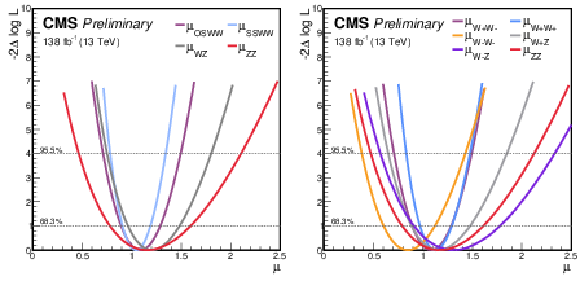
png pdf |
Figure 8:
The two figures show the likelihood profiles from the combined fit for the various POIs. The left figure shows the $ -2\Delta \log L $ profiles for the 4-POIs model while the right one shows the same profiles in the 6-POIs fit. |
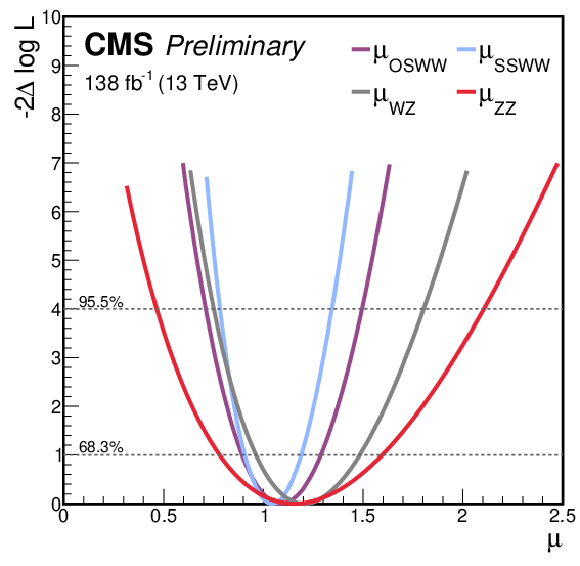
png pdf |
Figure 8-a:
The two figures show the likelihood profiles from the combined fit for the various POIs. The left figure shows the $ -2\Delta \log L $ profiles for the 4-POIs model while the right one shows the same profiles in the 6-POIs fit. |
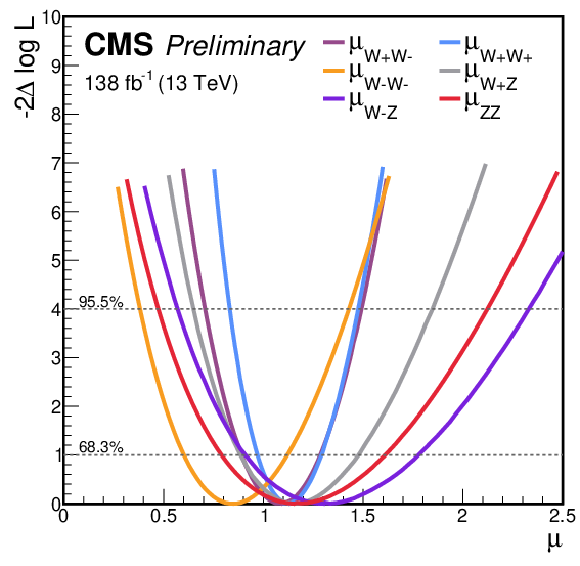
png pdf |
Figure 8-b:
The two figures show the likelihood profiles from the combined fit for the various POIs. The left figure shows the $ -2\Delta \log L $ profiles for the 4-POIs model while the right one shows the same profiles in the 6-POIs fit. |
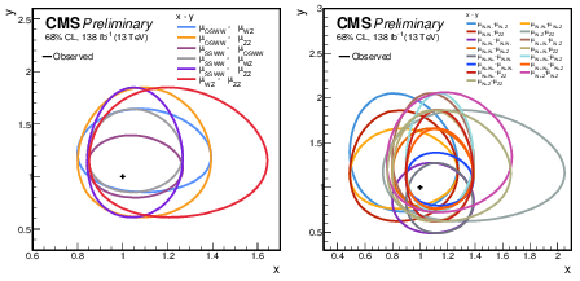
png pdf |
Figure 9:
Summary plots of the two-dimensional fits are presented. The left plot displays the 68% confidence level intervals for all pairs of parameters of interest in the 4-POIs model, with the legend listing the POI on the x-axis first, followed by the POI on the y-axis. The right plot provides the corresponding intervals for the 6-POIs model. In all cases, all parameters of interest except the two under study are profiled in the maximum likelihood fit along with the nuisance parameters. |
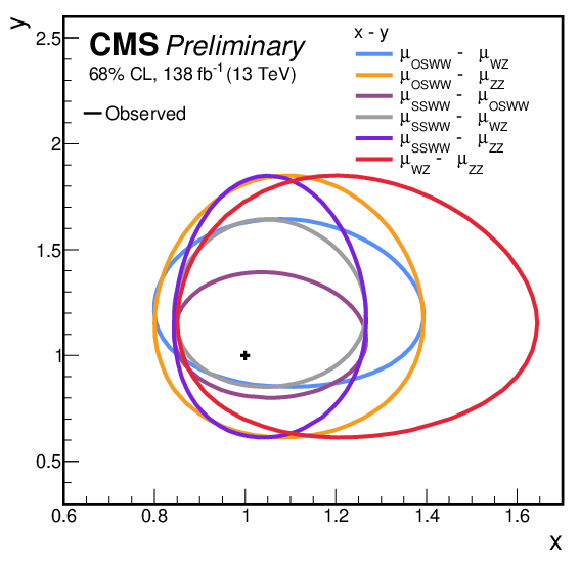
png pdf |
Figure 9-a:
Summary plots of the two-dimensional fits are presented. The left plot displays the 68% confidence level intervals for all pairs of parameters of interest in the 4-POIs model, with the legend listing the POI on the x-axis first, followed by the POI on the y-axis. The right plot provides the corresponding intervals for the 6-POIs model. In all cases, all parameters of interest except the two under study are profiled in the maximum likelihood fit along with the nuisance parameters. |
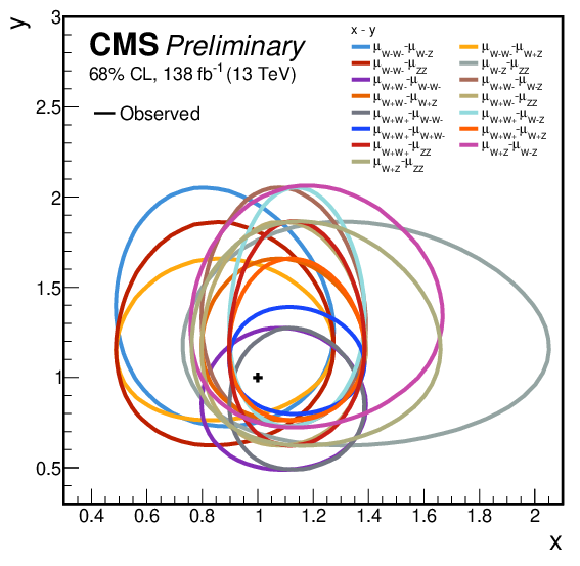
png pdf |
Figure 9-b:
Summary plots of the two-dimensional fits are presented. The left plot displays the 68% confidence level intervals for all pairs of parameters of interest in the 4-POIs model, with the legend listing the POI on the x-axis first, followed by the POI on the y-axis. The right plot provides the corresponding intervals for the 6-POIs model. In all cases, all parameters of interest except the two under study are profiled in the maximum likelihood fit along with the nuisance parameters. |
| Tables | |

png pdf |
Table 1:
Summary of the analyses considered in the combination. $ \ell $ denotes either an electron or muon, $ \tau_h $ an hadronicaly decaying $ \tau $ lepton and $ j $ is the shorthand notation for a parton. |
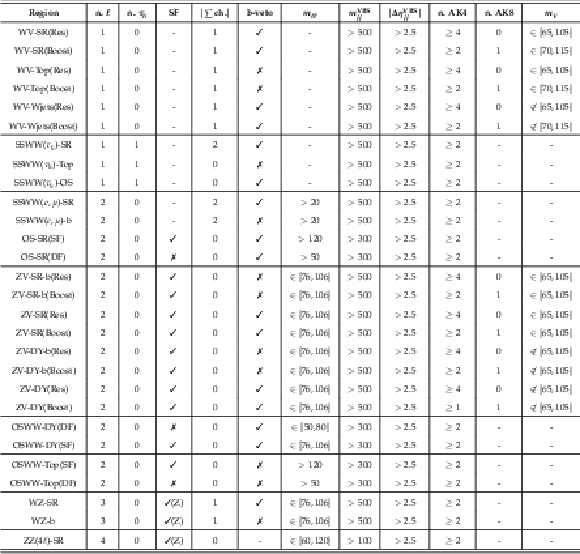
png pdf |
Table 2:
Summary of the signal and control regions defined in the analyses entering the combination, including the requirements ensuring their orthogonality. The second column is the number of light leptons ($ \ell = e, \mu $), and the third column is the number of hadronically decaying tau leptons. The same-flavor requirement for charged leptons is denoted as SF. A check mark indicates that the SF condition is applied, a cross means it is inverted (different-flavour), and no symbol signifies no restriction on lepton flavors. $ |\sum $ ch.$ | $ is the sum of the electrical charges for leptons in the final state. The b-veto column uses check mark to indicate regions that veto b-jets, a cross for regions requiring at least one b-jet, and no symbol for no restriction on b-jets. $ m_{\ell\ell} $ denotes the invariant mass of a charged dilepton pair and is defined in GeV. In WZ and ZZ cases, $ m_{\ell\ell} $ and SF refer respectively to the invariant mass and same flavour requirements of the Z boson decay candidates. The next two columns are the invariant mass, in units of GeV, of the two VBS jets and the $ \eta $ separation between them. The table finally presents the number of small-radius (AK4) and large-radius (AK8) jets, along with the invariant mass, in GeV, of the hadronically decaying vector boson candidate (W or Z). |
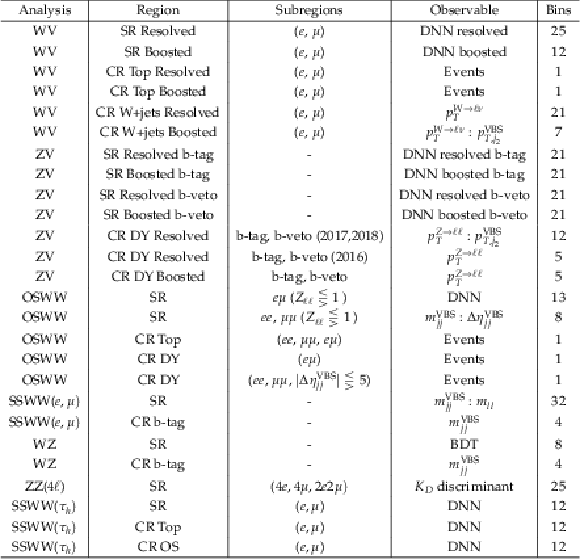
png pdf |
Table 3:
Phase space regions included in the combined fit, along with the corresponding observables and the number of bins. Bidimensional observables are represented with a colon separating the two components. For each subregion, a template is defined based on the specified observable and the number of bins. If the data-taking year is not explicitly specified in the subregion column, an independent template is included for each individual year of data-taking. |

png pdf |
Table 4:
Observed values of the signal strengths $ \mu^i = \sigma^i/\sigma^i_{\text{SM}} $ and statistical significance ($ \sigma^i $) from the VBS combination. The top row reports the results for the model with four signal strengths while the bottom row reports the same results but splitting the signal strengths for the W boson electrical charge. The expected results are reported within brackets. For the expected signal strengths, only the $ \pm $ 1 standard deviation uncertainty is reported as the central value is assumed to be 1. |
| Summary |
| This study presents the most comprehensive statistical combination of vector boson scattering (VBS) processes to date, integrating results from seven analyses. The fully leptonic final states are SSWW($ e,\mu $), $ pp \rightarrow W^\pm W^\pm jj \rightarrow 2\ell^\pm 2\nu jj $; SSWW($ \tau_h $), $ pp \rightarrow W^\pm W^\pm jj \rightarrow \ell^\pm \tau_h^{\pm} 2\nu jj $; OSWW, $ pp \rightarrow W^+ W^{-} jj \rightarrow \ell^+ \ell^{-} 2\nu jj $; WZ, $ pp \rightarrow W^\pm Z jj \rightarrow 3\ell \nu jj $; and ZZ(4 $ \ell $), $ pp \rightarrow ZZ jj \rightarrow 4\ell jj $, where $ \ell = e, \mu $. The semileptonic final states are WV ($ pp \rightarrow W^\pm V jj \rightarrow \ell \nu jjjj $) and ZV ($ pp \rightarrow Z V jj \rightarrow 2\ell jjjj $) where $ V $ (W,Z) denotes an hadronically decaying vector boson $ V\rightarrow jj $. Electroweak (EW) VBS production signal strengths are measured in two configurations: one merging W boson electric charges with four free parameters ($ \mu_{\text{SSWW}} $, $ \mu_{\text{OSWW}} $, $ \mu_{\text{WZ}} $, $ \mu_{\text{ZZ}} $) and another splitting W boson charges with six parameters ($ \mu_{W^+W^+} $, $ \mu_{W^{-}W^{-}} $, $ \mu_{W^+W^{-}} $, $ \mu_{W^+Z} $, $ \mu_{W^{-}Z} $, $ \mu_{ZZ} $). The EW signal strengths are measured based on a simultaneous fit of the seven channels. Interference effects between QCD and EW diboson production are negligible in all channels except SSWW($ e,\mu $) and ZZ, where they are treated as part of the EW signal. The results for the four-parameter model are $ \mu_{\text{SSWW}} = $ 1.04 $ ^{+0.14}_{-0.14} $, $ \mu_{\text{OSWW}} = $ 1.09 $ ^{+0.21}_{-0.18} $, $ \mu_{\text{WZ}} = $ 1.19 $ ^{+0.28}_{-0.23} $, and $ \mu_{\text{ZZ}} = $ 1.15 $ ^{+0.44}_{-0.37} $. For the six-parameter model the results are $ \mu_{W^+W^+} = $ 1.11 $ ^{+0.17}_{-0.15} $, $ \mu_{W^{-}W^{-}} = $ 0.84 $ ^{+0.27}_{-0.24} $, $ \mu_{W^+W^{-}} = $ 1.08 $ ^{+0.20}_{-0.19} $, $ \mu_{W^+Z} = $ 1.15 $ ^{+0.32}_{-0.27} $, $ \mu_{W^{-}Z} = $ 1.30 $ ^{+0.47}_{-0.40} $, and $ \mu_{ZZ} = $ 1.16 $ ^{+0.44}_{-0.38} $. Simultaneous two-dimensional fits were performed for all VBS EW production components. The compatibility between the observed data and the Standard Model (SM) predictions was evaluated differentially using the $ \log(S/B) $ observable. Overall, all one-dimensional and two-dimensional measurements are found to be consistent with SM predictions at the 68% confidence level. |
| References | ||||
| 1 | ATLAS Collaboration | Observation of a new particle in the search for the Standard Model Higgs boson with the ATLAS detector at the LHC | PLB 716 (2012) 1 | 1207.7214 |
| 2 | CMS Collaboration | Observation of a New Boson at a Mass of 125 GeV with the CMS Experiment at the LHC | PLB 716 (2012) 30 | CMS-HIG-12-028 1207.7235 |
| 3 | CMS Collaboration | Observation of a New Boson with Mass Near 125 GeV in $ pp $ Collisions at $ \sqrt{s} $ = 7 and 8 TeV | JHEP 06 (2013) 081 | CMS-HIG-12-036 1303.4571 |
| 4 | CMS Collaboration | A portrait of the Higgs boson by the CMS experiment ten years after the discovery | Nature 607 (2022) | CMS-HIG-22-001 2207.00043 |
| 5 | ATLAS Collaboration | A detailed map of Higgs boson interactions by the ATLAS experiment ten years after the discovery | Nature 607 (2022) | 2207.00092 |
| 6 | F. Englert and R. Brout | Broken Symmetry and the Mass of Gauge Vector Mesons | PRL 13 (1964) 321 | |
| 7 | P. W. Higgs | Broken symmetries, massless particles and gauge fields | PL 12 (1964) 132 | |
| 8 | P. W. Higgs | Broken Symmetries and the Masses of Gauge Bosons | PRL 13 (1964) 508 | |
| 9 | G. S. Guralnik, C. R. Hagen, and T. W. B. Kibble | Global Conservation Laws and Massless Particles | PRL 13 (1964) 585 | |
| 10 | P. W. Higgs | Spontaneous Symmetry Breakdown without Massless Bosons | PR 145 (1966) 1156 | |
| 11 | T. W. B. Kibble | Symmetry breaking in nonAbelian gauge theories | PR 155 (1967) 1554 | |
| 12 | H. G. J. Veltman | The Equivalence Theorem | PRD 41 (1990) 2294 | |
| 13 | H.-J. He, Y.-P. Kuang, and X.-y. Li | On the precise formulation of equivalence theorem | PRL 69 (1992) 2619 | |
| 14 | B. W. Lee, C. Quigg, and H. B. Thacker | Weak interactions at very high energies: The role of the higgs-boson mass | PRD 1 (1977) 6 | |
| 15 | B. W. Lee, C. Quigg, and H. B. Thacker | Strength of weak interactions at very high energies and the higgs boson mass | PRL 3 (1977) 8 | |
| 16 | D. Espriu and B. Yencho | Longitudinal WW scattering in light of the \textquotedblleftHiggs boson\textquotedblright discovery | PRD 87 (2013) | 1212.4158 |
| 17 | J. Chang, K. Cheung, C.-T. Lu, and T.-C. Yuan | WW scattering in the era of post-Higgs-boson discovery | PRD 87 (2013) 093005 | 1303.6335 |
| 18 | O. J. P. Eboli, M. C. Gonzalez-Garcia, and J. K. Mizukoshi | p p ---\ensuremath> j j e+- mu+- nu nu and j j e+- mu-+ nu nu at O( alpha(em)**6) and O(alpha(em)**4 alpha(s)**2) for the study of the quartic electroweak gauge boson vertex at CERN LHC | PRD 74 (2006) 073005 | hep-ph/0606118 |
| 19 | CMS Collaboration | Precision luminosity measurement in proton-proton collisions at $ \sqrt{s} = $ 13 TeV in 2015 and 2016 at CMS | EPJC 81 (2021) | CMS-LUM-17-003 2104.01927 |
| 20 | CMS Collaboration | CMS luminosity measurement for the 2017 data-taking period at $ \sqrt{s}= $ 13 TeV | CMS Physics Analysis Summary, 2018 CMS-PAS-LUM-17-004 |
CMS-PAS-LUM-17-004 |
| 21 | CMS Collaboration | CMS luminosity measurement for the 2018 data-taking period at $ \sqrt{s}= $ 13 TeV | CMS Physics Analysis Summary, 2019 CMS-PAS-LUM-18-002 |
CMS-PAS-LUM-18-002 |
| 22 | CMS Collaboration | The CMS Experiment at the CERN LHC | JINST 3 (2008) S08004 | |
| 23 | CMS Collaboration | Measurements of production cross sections of WZ and same-sign WW boson pairs in association with two jets in proton-proton collisions at $ \sqrt{s} = $ 13 TeV | PLB 809 (2020) 135710 | CMS-SMP-19-012 2005.01173 |
| 24 | CMS Collaboration | Study of same-sign W boson scattering and anomalous couplings in events with one tau lepton from pp collisions at $ \sqrt{s} $ = 13 TeV | CMS-SMP-22-008 2410.04210 |
|
| 25 | CMS Collaboration | Observation of electroweak W+W\ensuremath- pair production in association with two jets in proton-proton collisions at s=13TeV | PLB 841 (2023) 137495 | CMS-SMP-21-001 2205.05711 |
| 26 | CMS Collaboration | Evidence for electroweak production of four charged leptons and two jets in proton-proton collisions at $ \sqrt {s} $ = 13 TeV | PLB 812 (2021) 135992 | CMS-SMP-20-001 2008.07013 |
| 27 | CMS Collaboration | Evidence for WW/WZ vector boson scattering in the decay channel \ensuremath\ell\ensuremath\nuqq produced in association with two jets in proton-proton collisions at s=13 TeV | PLB 834 (2022) 137438 | CMS-SMP-20-013 2112.05259 |
| 28 | CMS Collaboration | Study of semileptonic vector boson scattering and anomalous quartic gauge coupling from proton-proton collisions at 13 TeV | CMS Physics Analysis Summary, 2025 CMS-PAS-SMP-22-011 |
CMS-PAS-SMP-22-011 |
| 29 | CMS Collaboration | Measurement of the electroweak production of W$ \gamma $ in association with two jets in proton-proton collisions at $ \sqrt{s} $ = 13 TeV | PRD 108 (2023) | CMS-SMP-21-011 2212.12592 |
| 30 | CMS Collaboration | Measurement of the electroweak production of Z$ \gamma $ and two jets in proton-proton collisions at $ \sqrt{s} = $ 13 TeV and constraints on anomalous quartic gauge couplings | PRD 104 (2021) 072001 | CMS-SMP-20-016 2106.11082 |
| 31 | CMS Collaboration | Particle-flow reconstruction and global event description with the CMS detector | JINST 12 (2017) | CMS-PRF-14-001 1706.04965 |
| 32 | CMS Collaboration | Performance of the CMS Level-1 trigger in proton-proton collisions at $ \sqrt{s} = $ 13 TeV | JINST 15 (2020) | CMS-TRG-17-001 2006.10165 |
| 33 | CMS Collaboration | The CMS trigger system | JINST 12 (2017) | CMS-TRG-12-001 1609.02366 |
| 34 | J. Alwall et al. | The automated computation of tree-level and next-to-leading order differential cross sections, and their matching to parton shower simulations | JHEP 07 (2014) 079 | 1405.0301 |
| 35 | J. Alwall et al. | Comparative study of various algorithms for the merging of parton showers and matrix elements in hadronic collisions | EPJC 53 (2008) 473 | 0706.2569 |
| 36 | P. Artoisenet, R. Frederix, O. Mattelaer, and R. Rietkerk | Automatic spin-entangled decays of heavy resonances in Monte Carlo simulations | JHEP 03 (2013) 015 | 1212.3460 |
| 37 | P. Nason | A New method for combining NLO QCD with shower Monte Carlo algorithms | JHEP 11 (2004) 040 | hep-ph/0409146 |
| 38 | S. Frixione and B. R. Webber | Matching NLO QCD computations and parton shower simulations | JHEP 06 (2002) 029 | hep-ph/0204244 |
| 39 | S. Frixione, P. Nason, and C. Oleari | Matching NLO QCD computations with Parton Shower simulations: the POWHEG method | JHEP 11 (2007) 070 | 0709.2092 |
| 40 | S. Alioli, P. Nason, C. Oleari, and E. Re | NLO vector-boson production matched with shower in POWHEG | JHEP 07 (2008) 060 | 0805.4802 |
| 41 | S. Alioli, P. Nason, C. Oleari, and E. Re | A general framework for implementing NLO calculations in shower Monte Carlo programs: the POWHEG BOX | JHEP 06 (2010) 043 | 1002.2581 |
| 42 | J. M. Campbell, R. K. Ellis, and W. T. Giele | A Multi-Threaded Version of MCFM | EPJC 75 (2015) | 1503.06182 |
| 43 | J. M. Campbell, R. K. Ellis, and C. Williams | Vector Boson Pair Production at the LHC | JHEP 07 (2011) 018 | 1105.0020 |
| 44 | J. M. Campbell and R. K. Ellis | An Update on vector boson pair production at hadron colliders | PRD 60 (1999) 113006 | hep-ph/9905386 |
| 45 | J. Campbell and T. Neumann | Precision Phenomenology with MCFM | JHEP 12 (2019) 034 | 1909.09117 |
| 46 | K. Hamilton, P. Nason, and G. Zanderighi | Finite quark-mass effects in the NNLOPS POWHEG+MiNLO Higgs generator | JHEP 05 (2015) 140 | 1501.04637 |
| 47 | S. Bolognesi et al. | On the Spin and Parity of a Single-Produced Resonance at the LHC | PRD 86 (2012) 095031 | 1208.4018 |
| 48 | T. Sjöstrand et al. | An introduction to PYTHIA 8.2 | Comput. Phys. Commun. 191 (2015) 159 | 1410.3012 |
| 49 | NNPDF Collaboration | Parton distributions for the LHC Run II | JHEP 04 (2015) 040 | 1410.8849 |
| 50 | NNPDF Collaboration | Parton distributions from high-precision collider data | EPJC 77 (2017) | 1706.00428 |
| 51 | P. Skands, S. Carrazza, and J. Rojo | Tuning PYTHIA 8.1: the Monash 2013 Tune | EPJC 74 (2014) | 1404.5630 |
| 52 | CMS Collaboration | Event generator tunes obtained from underlying event and multiparton scattering measurements | EPJC 76 (2016) | CMS-GEN-14-001 1512.00815 |
| 53 | CMS Collaboration | Extraction and validation of a new set of CMS PYTHIA8 tunes from underlying-event measurements | EPJC 80 (2020) | CMS-GEN-17-001 1903.12179 |
| 54 | A. Ballestrero et al. | Precise predictions for same-sign W-boson scattering at the LHC | EPJC 78 (2018) | 1803.07943 |
| 55 | B. J ä ger et al. | Parton-shower effects in Higgs production via Vector-Boson Fusion | EPJC 80 (2020) | 2003.12435 |
| 56 | R. Covarelli, M. Pellen, and M. Zaro | Vector-Boson scattering at the LHC: Unraveling the electroweak sector | Int. J. Mod. Phys. A 36 (2021) | 2102.10991 |
| 57 | C. Bierlich et al. | A comprehensive guide to the physics and usage of PYTHIA 8.3 | SciPost Phys. Codeb. 2022 (2022) 8 | 2203.11601 |
| 58 | GEANT4 Collaboration | GEANT4 - A Simulation Toolkit | NIM A 506 (2003) 250 | |
| 59 | CMS Collaboration | Identification of heavy-flavour jets with the CMS detector in pp collisions at 13 TeV | JINST 13 (2018) | CMS-BTV-16-002 1712.07158 |
| 60 | Particle Data Group Collaboration | Review of Particle Physics | PTEP 2022 (2022) 083C01 | |
| 61 | D. L. Rainwater, R. Szalapski, and D. Zeppenfeld | Probing color singlet exchange in $ Z $ + two jet events at the CERN LHC | PRD 54 (1996) 6680 | hep-ph/9605444 |
| 62 | E. Bols et al. | Jet Flavour Classification Using DeepJet | JINST 15 (2020) | 2008.10519 |
| 63 | CMS Collaboration | Measurement of the single top quark and antiquark production cross sections in the $ t $ channel and their ratio in proton-proton collisions at $ \sqrt{s}= $ 13 TeV | PLB 800 (2020) 135042 | CMS-TOP-17-011 1812.10514 |
| 64 | CMS Collaboration | Measurement of Higgs Boson Production and Properties in the WW Decay Channel with Leptonic Final States | JHEP 01 (2014) 096 | CMS-HIG-13-023 1312.1129 |
| 65 | Y. Gao et al. | Spin Determination of Single-Produced Resonances at Hadron Colliders | PRD 81 (2010) 075022 | 1001.3396 |
| 66 | I. Anderson et al. | Constraining Anomalous HVV Interactions at Proton and Lepton Colliders | PRD 89 (2014) | 1309.4819 |
| 67 | A. V. Gritsan, R. Röntsch, M. Schulze, and M. Xiao | Constraining anomalous Higgs boson couplings to the heavy flavor fermions using matrix element techniques | PRD 94 (2016) | 1606.03107 |
| 68 | The ATLAS Collaboration, The CMS Collaboration, The LHC Higgs Combination Group | Procedure for the LHC Higgs boson search combination in Summer 2011 | Technical Report CMS-NOTE-2011-005, ATL-PHYS-PUB-2011-11, 2011 | |
| 69 | ATLAS and CMS Collaborations | Measurements of the Higgs boson production and decay rates and constraints on its couplings from a combined ATLAS and CMS analysis of the LHC pp collision data at $ \sqrt{s}= $ 7 and 8 TeV | JHEP 08 (2016) 045 | 1606.02266 |
| 70 | CMS Collaboration | The CMS statistical analysis and combination tool: \textscCombine | Comput. Softw. Big Sci. 8 (2024) 19 | CMS-CAT-23-001 2404.06614 |
| 71 | G. Cowan, K. Cranmer, E. Gross, and O. Vitells | Asymptotic formulae for likelihood-based tests of new physics | EPJC 71 (2011) 1554 | 1007.1727 |
| 72 | CMS Collaboration | Jet energy scale and resolution in the CMS experiment in pp collisions at 8 TeV | JINST 12 (2017) | CMS-JME-13-004 1607.03663 |
| 73 | CMS Collaboration | Measurement of the inelastic proton-proton cross section at $ \sqrt{s}= $ 13 TeV | JHEP 07 (2018) 161 | CMS-FSQ-15-005 1802.02613 |
| 74 | J. Butterworth et al. | PDF4LHC recommendations for LHC Run II | JPG 43 (2016) 023001 | 1510.03865 |
| 75 | R. J. Barlow and C. Beeston | Fitting using finite Monte Carlo samples | Comput. Phys. Commun. 77 (1993) 219 | |
| 76 | J. S. Conway | Incorporating Nuisance Parameters in Likelihoods for Multisource Spectra | PHYSTAT 201 (2011) 115 | 1103.0354 |

|
Compact Muon Solenoid LHC, CERN |

|

|

|

|

|

|